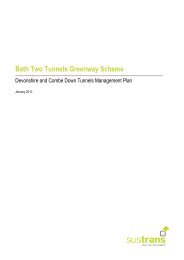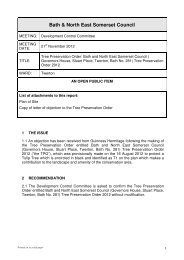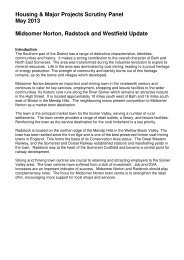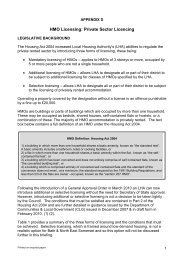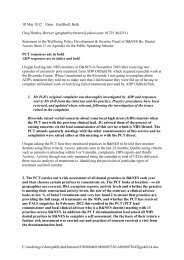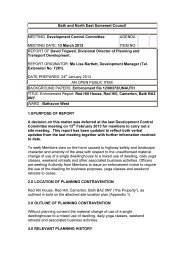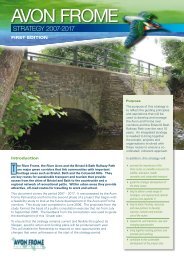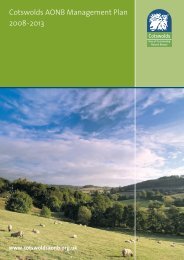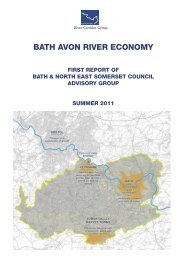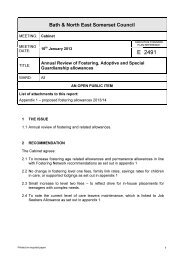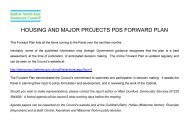Bath Western Riverside Supplementary Planning Document (SPD)
Bath Western Riverside Supplementary Planning Document (SPD)
Bath Western Riverside Supplementary Planning Document (SPD)
You also want an ePaper? Increase the reach of your titles
YUMPU automatically turns print PDFs into web optimized ePapers that Google loves.
‘Embedded’ SustainabilityBackground1.5.26 If BWR is to deliver a truly sustainable community, inall its forms, it must aspire to achieve ‘zero carbon’and ‘zero waste’ objectives. It will be best placed toachieve this if the redevelopment of the area is basedon the concept of ‘embedded’ sustainability, that is,the development is designed and constructed in away that means that being sustainable is an ingrainedor inherent way of living, visiting or working in the area,rather than just one choice. This can be achievedthrough a variety of means, such as:the way that buildings are constructed, in order tominimise energy consumptionthe level of encouragement that is given to alternativemodes of travel to the private car, such as theprovision of secure cycle storagethe way that the design and layout of buildingsenables the easier segregation and collection ofrecyclable material.1.5.27 Embedded sustainability does not mean thatdevelopments become sustainable through ‘bolt-on’solutions but through designing for sustainability fromthe earliest stages to ensure, for example, thatbuildings are oriented and constructed to maximiseenergy efficiency and minimise energy need. Provisionshould be made for firstly, renewable energy andsecondly, highly efficient fossil fuel energy as a lastresort.1.5.28 In setting out the need for the prudent use of naturalresources, PPS1 sets out the objective of minimisingthe need to consume new resources over the lifetime ofa development by making more effective use or re-useof existing resources, rather than making new demandson the environment, and to promote and encourage theuse of renewable resources (for example by thedevelopment of renewable energy). PPS1 adds thatlocal authorities should promote resource and energyefficient buildings, community heating schemes, the useof combined heat and power, small scale renewableand low carbon energy schemes in developments, thesustainable use of water resources, and the use ofsustainable drainage systems in the management ofrun-off.1.5.29 PPS22: Renewable Energy sets out that RegionalSpatial Strategies should set targets for renewableenergy. The draft RSS for the South West is currently inpreparation, however, a pre-consultation draft of theRSS (October 2005) provides useful guidance that canbe applied to BWR:“Emerging Guidance on Sustainability from theSouth West RSSMajor development proposals must be accompanied byan “Energy Use Assessment” which describes howmuch energy is expected to be used within theproposal and goes on to consider ways by which the“Energy Heirarchy” can be put into effect.All developments will meet a proportion of their energyfrom renewable sources. Larger developments will beexpected to provide, as a minimum, sufficient on-siterenewable energy to reduce carbon dioxide emissionsfrom energy use of the site by 10%.By 2026 the measurable outcome expected is that allnew dwellings will conform to sustainable constructionstandards and will make a significant contributiontowards reducing net per capita domestic energyrequirements and greenhouse gas emissions. Buildingto sustainable construction standards seeks theachievement of best practice in sustainableconstruction by:(i)(ii)requiring all new and refurbished buildings toachieve the requirements of the emrging nationalCode for Sustainable Buildingspromoting the principles contained within FutureFoundations, the South West’s sustainableconstruction charter(iii) seeking to minimise lifetine resources use, energyconsumption, water use and waste production, forexample through the setting of BREEAM and EcoHomes “Very Good” and “Excellent” standards(iv) minimising the environmental impact of new andrefurbished buildings, including reducing air, land,water, noise and light pollution throughout thebuilding’s lifetime, and(v)promoting the use of sustainable drainagesolutions to minimise flood risk associated withnew developmentDevelopment should be within environmental limits by:(i)(ii)ensuring that new developments, regenerationareas and major refurbishments are “future proofed”so that they can cope with or are able to easilyadapt to climate change impactsrequiring that all new developments, regenerationareas and major refurbishments assess how theywill contribute to stabilising the region’s ecologicalfootprint by reducing the consumption of resourcesduring the lifecycle of the development down to thatwhich can be provided by one planet(iii) requiring the submission of sustainability statementsto accompany planning applications, the content ofwhich should meet or exceed the requirements ofthe South West Regional checklist for SustainableDevelopmentsThe Energy HeirarchyWith reference to PPS22’s emphasis on the importanceof developing positively expressed policies on buildingintegrated renewables, this involves reducing buildingenergy demand through energy efficiency and lowenergy design, before meeting the resulting demandfrom first renewable energy and then fossil fuels or gridelectricity. This approach has been characterised as theEnergy Heirarchy within the South West and will ensurethat energy efficiency opportunities are maximisedbefore renewable energy is considered within proposalsfor new developments.<strong>Bath</strong> <strong>Western</strong> <strong>Riverside</strong> <strong>Supplementary</strong> <strong>Planning</strong> <strong>Document</strong> 7



